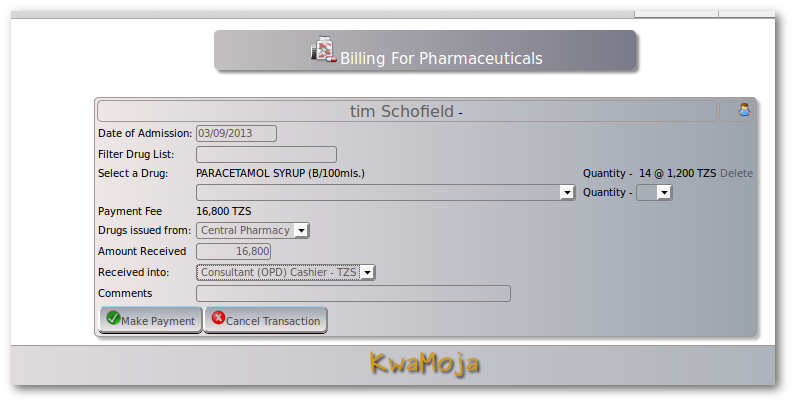People always talk about the use of +KwaMoja in manufacturing, and distribution businesses, but +KwaMoja also plays a big part in the administration of several hospitals.
We have written some extensions to +KwaMoja that enable it to link seamlessly with an open source health information system project Care2x. All the financial and inventory transactions are delegated to +KwaMoja , and Care2x deals with the clinical information side.
When a patient is admitted in Care2x, +KwaMoja Care2x will send this information to +KwaMoja and if the patient is not already setup as a customer they will be setup. The interface with Care2x uses customer branches to indicate who will be paying the bill. If the patient pays in cash then they will get a branch with a code of CASH setup. If they are an insurance customer then they get a branch with an identical code to the customer code for that insurance company.
When any transaction occurs in Care2x which affects the financial status of the hospital then that information is sent to +KwaMoja.
 So, when as in this example the doctor prescribes drugs for a patient in Care2x the transaction will be sent to +KwaMoja.
So, when as in this example the doctor prescribes drugs for a patient in Care2x the transaction will be sent to +KwaMoja.
The cashier, who uses +KwaMoja will search for this patient and will be shown a list of all unpaid transactions for that patient, as can be seen here.
Once the items are paid for then the cashier will give the patient a receipt, which they can then exchange for the drugs, or test, or whatever the item is for.
If the item is a physical item, such as drugs as in this case +KwaMoja will automatically deduct the amount from the stock held. +KwaMoja will also do all the double entry bookkeeping for this transaction behind the scenes.
At the end of the cashiers shift, they can produce a report of all monies that they have taken, which should tally with the physical amount of money they have. This is transferred both physically and within +KwaMoja to a central cash account.
Using +KwaMoja the hospital can gain greater efficiency. It can also gain greater security against fraud, and as +KwaMoja is web based if there are remote funders of the hospital, such as a western charity, or central government, they get greater visibility on how the hospital is performing. All this leads to better health care for the people, and +KwaMoja is playing a central part in this.
We have written some extensions to +KwaMoja that enable it to link seamlessly with an open source health information system project Care2x. All the financial and inventory transactions are delegated to +KwaMoja , and Care2x deals with the clinical information side.
When a patient is admitted in Care2x, +KwaMoja Care2x will send this information to +KwaMoja and if the patient is not already setup as a customer they will be setup. The interface with Care2x uses customer branches to indicate who will be paying the bill. If the patient pays in cash then they will get a branch with a code of CASH setup. If they are an insurance customer then they get a branch with an identical code to the customer code for that insurance company.
When any transaction occurs in Care2x which affects the financial status of the hospital then that information is sent to +KwaMoja.
 So, when as in this example the doctor prescribes drugs for a patient in Care2x the transaction will be sent to +KwaMoja.
So, when as in this example the doctor prescribes drugs for a patient in Care2x the transaction will be sent to +KwaMoja.The cashier, who uses +KwaMoja will search for this patient and will be shown a list of all unpaid transactions for that patient, as can be seen here.
Once the items are paid for then the cashier will give the patient a receipt, which they can then exchange for the drugs, or test, or whatever the item is for.
If the item is a physical item, such as drugs as in this case +KwaMoja will automatically deduct the amount from the stock held. +KwaMoja will also do all the double entry bookkeeping for this transaction behind the scenes.
At the end of the cashiers shift, they can produce a report of all monies that they have taken, which should tally with the physical amount of money they have. This is transferred both physically and within +KwaMoja to a central cash account.
Using +KwaMoja the hospital can gain greater efficiency. It can also gain greater security against fraud, and as +KwaMoja is web based if there are remote funders of the hospital, such as a western charity, or central government, they get greater visibility on how the hospital is performing. All this leads to better health care for the people, and +KwaMoja is playing a central part in this.

